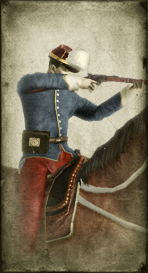
Basic Unit Statistics (can be modified by difficulty level, arts, skills, traits and retainers)
| Recruitment Cost | 1320 | |
| Upkeep Cost | 170 | |
| Melee Attack | 15 | 42% |
| Charge Bonus | 20 | 40% |
| Bonus vs Cavalry | 0 | 0% |
| Range | 125 | 19% |
| Accuracy | 40 | 40% |
| Reloading Skill | 80 | 80% |
| Ammunition | 60 | 75% |
| Melee Defence | 10 | 28% |
| Armour | 2 | 13% |
| Morale | 12 | 24% |
Strengths & Weaknesses
- Good accuracy and very fast reload rate.
- Good in melee.
- Weak against missile attacks and spear-armed units.
- Very good morale.
Abilities
- Wedge Formation - Trained to charge in a wedge formation in order to better penetrate enemy formations
Requires
Description
The Imperial Guard are good all-round cavalrymen, a force any general should be glad to command.
These cavalrymen are extremely able horsemen and can move quickly across the battlefield to harass enemy flanks or reinforce a dangerous position. They are armed with carbines and are well trained in their use, giving them very good accuracy and reload times. If necessary, they can even dismount to deliver slightly more effective fire. Unlike some other missile-firing troops, the Imperial Guard are also rather handy in close combat against infantry. They will suffer casualties in pitched battles against other cavalry, and are no more immune than anyone else to the killing power of an artillery bombardment. It is difficult to reload any kind of weapon, control a horse and fight a battle at the same time. Because of this simple truth, the Spencer repeating carbine and similar weapons were a godsend to cavalrymen. The carbine saw extensive use in the American Civil War, and although originally Northern weapons, the Spencer carbines, and the longer Spencer rifles, were captured and used by the South in substantial numbers. The Spencer mechanism used a lever to open the breech and extract a fired cartridge, while a spring-loaded tube in the stock fed a new round into the chamber. The gun could be fired as fast as the gunner could work the lever and pull the trigger. This meant that sometimes fire was stopped as the gunners could no longer see through the dense clouds of smoke they had just created! The carbine fired a big .56 inch calibre bullet that could drop a man in his tracks. Thanks to the lever action of the carbine the cartridge including charge and bullet could not be too long, so it was rather underpowered, giving the gun a relatively short range.
